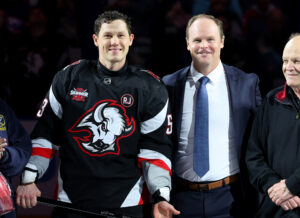NHL player development seems to always result in more questions than answers. How likely is it for a top pick to pan out? What makes a player a “steal”? Last Word On Hockey will be starting a new series on how to properly develop prospects from all different spots throughout the draft. This week’s piece involves draft picks in the back half of the first round and how they were used early in their careers.
NHL Player Development Of First-Round Picks
In the span of 2005 through 2015, there were 84 total selections made between 16th overall and 30th overall on forwards playing in North America. Looking at all 84 forwards, they were split into different categories. Those categories were “Forwards Deemed NHL-Ready and Brought In Immediately When Ready,” “Forwards Near NHL-Ready and Brought In Immediately When Near-Ready,” “Forwards Rushed Slightly,” “Forwards Rushed,” “Forwards Forced,” “A Little Patience,” “Patience,” and “Too Much Patience.”
There were four forwards who fell into the seventh category, “too much patience,” on the list. Of those four players, one made an NHL impact in their DY+6 season. That player was Evgeny Svechnikov.
In this piece, we will be using stats from eliteprospects (raw stats) and hockey-reference (ice time). Additionally, the analytics we are using are as follows: even-strength offence goals above replacement (EVO), even-strength defence goals above replacement (EVD), wins above replacement (WAR) and goals above replacement (GAR). Those analytics are from evolving-hockey (subscription required).
NHL Player Development Of Evgeny Svechnikov
Evgeny Svechnikov, drafted 19th overall in the 2015 NHL draft by the Detroit Red Wings, came out of the QMJHL’s Cape Breton Screaming Eagles organization. In his DY-1 season, Svechnikov played in Russia with the MHL’s Bars Kazan. He scored 14 goals and 13 assists for 27 points in 29 games, for 0.931 points per game. That ranked 30th amongst the aforementioned 84 forwards in DY-1 production. Joining Cape Breton, he scored 32 goals and 46 assists for 78 points in 55 games, for 1.418 points per game. That ranked 17th amongst the same 84 forwards, in DY production.
After being drafted, Svechnikov would play just one more QMJHL season before heading to the AHL, where he played three seasons in four years before making his first true NHL impact. In that final QMJHL season, he scored 32 goals and 47 assists for 79 points in 50 games, for 1.58 points per game. That ranked ninth amongst the 82 forwards that are still outside the NHL in their DY+1 seasons. Making the jump to the AHL, he scored 20 goals and 31 assists for 51 points in 74 games, for 0.689 points per game. That ranked 52nd among the 70 forwards still outside the NHL in DY+2 production.
Svechnikov’s Continued AHL Time
Playing another season in the AHL, Svechnikov would score seven goals and 16 assists for 23 points in 57 games, for 0.404 points per game. That ranked 33rd out of the 46 forwards still outside the NHL in DY+3 production. The following season, what would have been his third as a pro, he did not play a single game. Thus, he lost his entire DY+4 season. However, he would return with 11 goals and 14 assists for 25 points in 51 games in the AHL, for 0.49 points per game. That ranked 13th out of the 24 forwards still outside the NHL in DY+5 production. Finally, he would get an extended stay at the NHL level the following year.
How Svechnikov Was Used
Svechnikov, finally getting a long look at the highest level, would still have to prove himself. He played four AHL games, scoring two points. In total, he only played 21 NHL games, and he averaged 11:49 time on ice per game. In that small and limited role, he scored three goals and five assists for eight points. Analytically, he brought even less to the table. His EVO (0.6) was the only stat above replacement level. Meanwhile, his EVD (-0.6), WAR (-0.1) and GAR (-0.6) were all below replacement level.
The following year, he would join the Winnipeg Jets. He would be a full-time NHLer there, getting in 72 games and averaging 10:45 per game. Again, he played a limited role, but this time over the course of an entire season. Svechnikov would score seven goals and 12 assists for 19 points, which again left a lot to be desired. The main positive? His underlying stats improved. His EVO (0.4) went down a bit, but his EVD (2.3) was far better. With the improved defensive impact, his WAR (0.4) and GAR (2.4) also improved by a decent margin.
Svechnikov In The Midst Of Year Three
Currently, Svechnikov is playing in his third NHL season. Now playing for the San Jose Sharks, Svechnikov is again a mainstay in the NHL. Thus far, he has played 42 games and has scored seven goals and six assists for 13 points, at the time of writing. He has done this while averaging 10:33 per game.
It’s clear that Evgeny Svechnikov, to this point, has not lived up to his billing as a first-round pick. Looking back, he had modest production in a league (MHL) where defence is an afterthought. Then, he joined a league where the defensive structure is not up to the same level as the other two surrounding junior leagues, by a noticeable margin (QMJHL). He missed a year of development with that full season of no games played and could not match his first professional season where he scored over 50 points.
Overall NHL Player Development Of Evgeny Svechnikov
The QMJHL was touched on when reviewing Alexis Lafreniere, so it won’t be talked about heavily when discussing Svechnikov. But the evidence continues to build that the scoring rates of young prospects in the QMJHL are over-valued. Plus, his major knee injury in the 2018-19 season caused him to miss an entire season of development. That injury happened during a preseason contest. The combination of maybe being overrated for his QMJHL production, plus the injury, then the small roles he played once he made the NHL all hindered his growth. But, he never proved he was deserving of a bigger role.
But again, he is still in his third season. There is still time for him to turn a corner, right? Well, he is 26, which should be the prime of his career. He has only carved out a bottom-six role to this point, and he hasn’t exactly been the best within that role either. But let’s take that context out, for now. He has averaged just shy of 11 minutes per game through his first three seasons, thus far. That puts him in the well-below-average tier of players in an ice-time study of first-round selections. What does that mean?
Probabilities Of Svechnikov’s Future
Looking at the study mentioned earlier, the best-case scenario seems wildly unlikely. He has a sub-2% chance of becoming “elite,” using career WAR/60 stats. The highest potential, based on probability using historical evidence, is a middle-six-level forward (35.29%). The next best odds are bottom-six calibre (25.49%), fringe-NHL calibre (19.61%), and finally, not NHL calibre and top-six calibre tied as fourth-best odds (15.69%). This is a case study, using WAR/60 which isn’t the most refined stat. So this study certainly isn’t the be-all, end-all of where a prospect will end up. But the patterns are there. Evgeny Svechnikov hasn’t proved himself. The ice time he has received has reflected that. Odds are against him.
Junior league stats via Elite Prospects, NHL stats via Hockey Reference, NHL analytics via Evolving Hockey
Ice Time Case Study research from Kyle Pereira
Main Photo: Stan Szeto-USA TODAY Sports






